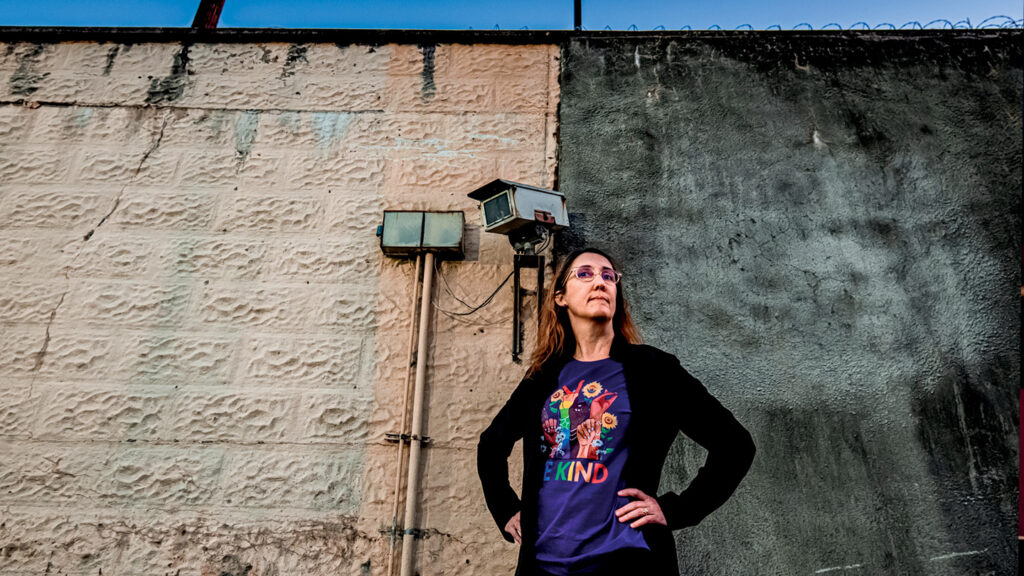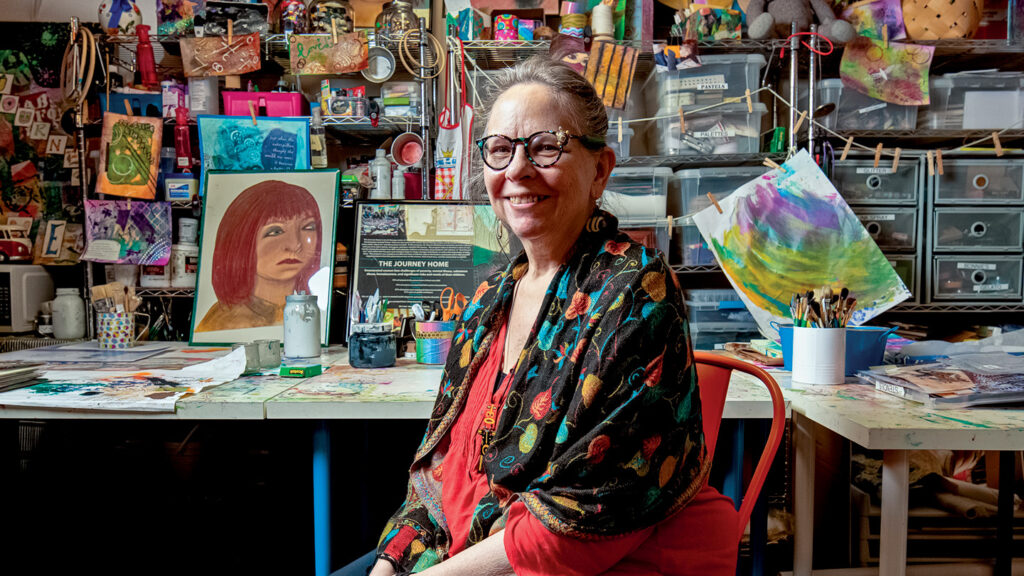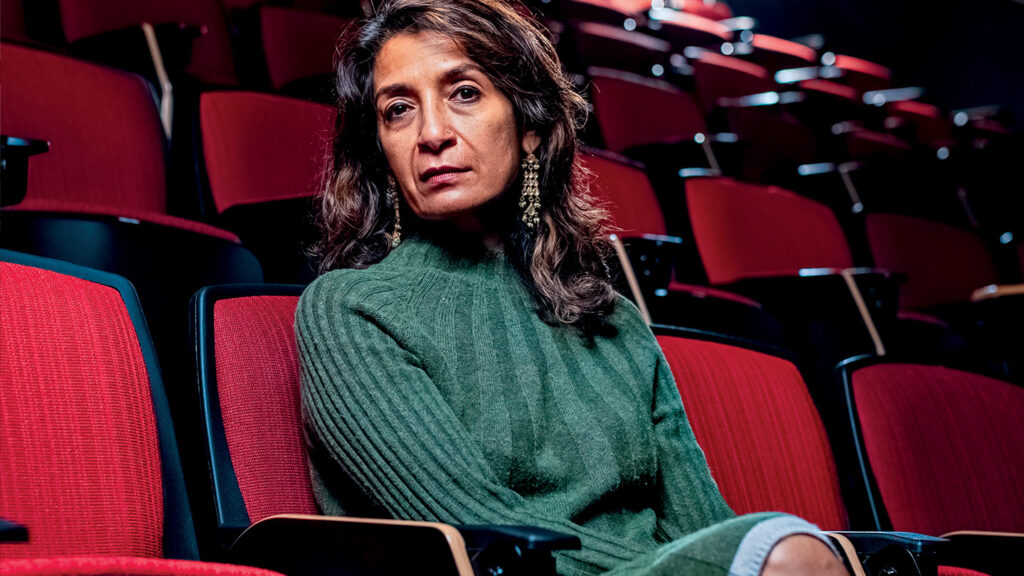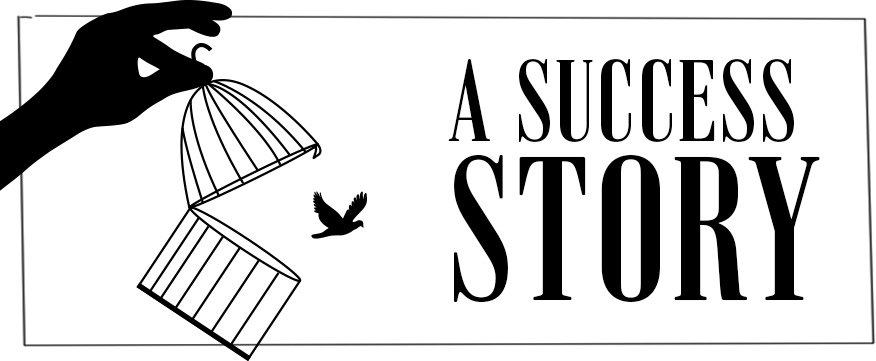Behind the Bars
The heavy clang of the door.
That’s the sound most people focus on when entering prison for the first time. While inevitable, it still startles. Even if you move through that door more than once, it’s hard to steel yourself against its clamor.
The sound summons a finality for some. For others, it piques anxiety, fears, and self-talk.
For all, it is a metal-on-metal alarm, alerting them of where they are, what they are about to face, and how it will impact their lives.
Lives do change inside there, some for the better and some, well, you know. That opportunity to change resides with all: officers, inmates, staff, visitors, and volunteers.
Such opportunities, prior to COVID, happened regularly for members of the College community as they have deepened relationships with women at the Northampton County Jail through College courses and programming as well as faculty and student projects, including a Guggenheim-winning feature-length documentary film that makes real the struggles for women inside and outside.
But during the pandemic, everyone languished in exile, whether in rooms at home or cells in prison. The severity of that sentence depended on how you managed the circumstances of confinement and confronted the chance to change.
Change, whether personal or systematic, is not easy. It’s harder when the pandemic ended most programming and enrichment programs for all incarcerated people, not just the silent surge of women.
According to the American Civil Liberties Union (ACLU), women are the fastest-growing correctional population nationwide, with local jails serving as the main factor in that growth. The number of women in jail has increased from nearly 8,000 in 1970 to 110,000 in 2014.
A 2019 study by the Prison Policy Initiative (PPI) shows 231,000 incarcerated women in the U.S. are almost equally split between state facilities (99,000) and local jails (101,000), with the remainder in youth, federal, or immigration detention. Nearly 60% of those women in local jails have not been convicted of a crime but simply are awaiting trial.
Convicted or not, the women in local jails, over 80,000, are there for nonviolent property, drug, or public order crimes, ranging from fraud to possession to DWI.
The ACLU indicates 99% of growth over the last 15 years is the result of pretrial incarceration. Jails have become a kind of purgatory for many of the women who have yet to stand trial because they have a harder time affording bail. PPI indicates that bail amounts often match a woman’s full yearly income.
The ramifications of this reality are compounded by the burden it places on the women and their children. PPI says 80% of women in jails are mothers, and many of them serve as primary caregivers for their children. With limited contact between a mother and a child, it’s not surprising that jail can exacerbate mental health issues for women, who also can bring in other issues like addiction, abuse, sexual trauma, and sexual identity.
The pressures, once released, are made worse by women facing unemployment, limited housing, court-ordered fines, and child services.
Maybe it shouldn’t surprise that the jail’s clamorous door often becomes the world’s heaviest revolving door.
Meet a few of the people on campus who are working to alleviate the pressures of jail, improve success upon release, and draw attention to this plight.

The Educator
Room 209 in the women’s section of the Northampton County Jail is a cinder block exercise space with a pull-up bar on the wall, folded basketball net looming overhead, and small unreachable rectangular window filtering in shards of evening light. Dotting the corners, camera-covered domes monitor the space as women in green jumpsuits arrange chairs in a circle.
It is 2019 during week three of Tara Gilligan’s community-based learning course, Women in the U.S. Criminal Justice System. About 12 Lafayette students have traveled here from the facility’s reception center, passing through the massive riot door after having their class materials moved through X-ray and their bodies wanded with a metal detector.
“The intellectual and emotional opportunities for personal transformation were equal despite not entering the local facility or building relationships with the women inside.”
–Tara Gilligan – assistant professor of women’s, gender, and sexuality studies
An unfamiliar energy hangs in the room as some students tape large photos and art to the walls while others take seats or linger in pockets. Soon other women enter in brown and green jumpsuits, the colors denoting their security level.
The class dynamic is ever changing. While the Lafayette students remain the same for the three-hour weekly class, the incarcerated women come and go. It seems to hinge on their release dates, circumstances, and willingness.
The Thursday night class has 50-60 pages of reading per week. Stacks of unstapled copies for next week sit on a desk, with colored slips of paper marking the start of a new article. Tonight the group will discuss four case studies that outline four women’s trials—how their crimes and news coverage resulted in different verdicts and public sentiment when compared to their male co-defendants.
In addition is the case of Myra Hindley. Her mug shot hangs on the cinder block wall: her hair as platinum as Marilyn Monroe and as coiffed as Jacqueline Kennedy, but her face emotionless. She’s looking every bit like the modern 1960s woman despite the fact that she and her partner, Ian Brady, murdered five children over the course of two years. The media held her up as more reprehensible and condemnable for being so unwomanly despite Brady’s major role in her life and the crimes.
Discussion ensues. Do the choices we make define what we are? Do the people we think love us lead us down paths or do we willingly go? Is evil something that happens for a moment or something you are for a lifetime?
Answers the students share are theoretical and philosophical until a woman in a green jumpsuit asks if each of them has seen their own mugshot or how they were written about in the press. A student in a Lafayette sweatshirt relates by asking if anyone has been shamed by their peers in group texts or social media.
“We share the same set of experiences,” someone says.
Maybe the line between inside and outside blurs out of focus at that moment, where it doesn’t matter if you are wearing Lafayette gear or a county-issued jumpsuit.
Maybe that moment becomes a catalyst, as often happens in young adults, and sparks a realization, ignites a new passion, or inspires a new lifepath.
Even when students were no longer allowed to enter the jail in spring 2020, a few weeks prior to the College making the decision to operate remotely and again when the class was held online in fall 2020, catalysts remained to ignite students’ learning.
“We turned it into a different course,” says Gilligan, assistant professor of women’s, gender, and sexuality studies, “where students heard from guest speakers, corresponded with women at a state facility, and brought issues of interest to the class.”
The class studied COVID in prison, the war on drugs, gender, motherhood, sexuality, life sentences, and restorative practices.
“The intellectual and emotional opportunities for personal transformation were equal despite not entering the local facility or building relationships with the women inside,” she says.

The Healing Artist
Bonnie Winfield, the former director of community partnerships and Landis Community Outreach Center, launched her first program at the jail in 2008 after a 2007 interview with an incarcerated woman revealed the lack of programming in the facility.
Winfield’s class was modeled after the Inside-Out Prison Exchange Program founded in 1997 at Temple University, which now boasts over 1,100 trained facilitators and nearly 350 college and university partners.
Despite her retirement, Winfield and Lafayette student volunteers, prior to COVID-19, continued to be inside four evenings per week with four different programs that fall under Winfield’s Journey Home nonprofit.
Journey Home programs include a book club/writing group, Zen coloring, restorative justice circle, and creative mindfulness. Each program is designed to bring respite, foster creativity, connect mind and body, and give voice to what is often unsayable.
“Our bodies keep score of the traumas we endure,” she says. “Art helps us express deeply, mindfulness can heal that trauma, and compassion can circle outward, like a drop in water, from ourselves to others, to strangers, to enemies.”
Lafayette students who find themselves volunteering in her programs cherish the work and relationships, and many take up the mantle and pursue careers and graduate work in restorative justice and art therapies.
But the pandemic ended all programming, and Winfield wondered how to continue to help the women during this harrowing time.
She turned to writing. A handful of women in the jail were transferred to state facilities. Winfield used a state-sanctioned email system and corresponded with them (at the cost of one dollar per message).
At the same time, several women who had been released began to visit Winfield’s studio a few times a week. Getting out of the house during COVID provided respite as they could make art together.
“It truly gave them purpose,” she says. More than that, it allowed them time to dream up some new ideas when word got around a young woman was set to be released.
Savannah, who had been in and out of the jail seven times, was headed to rehab. It was a big step for her. She lost her mother, Terra, who also went in and out of the jail’s revolving door, to an overdose during one of her mother’s stints outside. Winfield wanted to be there for Savannah’s release and brought a few items she might need— simple toiletries and a mask.
The women coming to the studio suggested a few more things and soon were assembling backpacks filled with personal items, gift cards, hygiene products, and antibacterial wipes.
Thus was born a new program called Operation Following Hope–Meet Me at the Prison Gate. Winfield and the women have now artfully painted boxes placed at locations across Easton to gather these supplies in order to help more women who walk through that door and usually have nothing as well as no one to meet them and nowhere to go.
But Savannah had someone to meet her. Maybe that is why she is on a more successful path this time.
“Dr. Bonnie has always been there for me, no matter what,” Savannah says. “She has been a constant in my life—inside, at my mother’s celebration of life, when I went back in, and before my trip to rehab—and I love her for it.”
Winfield, along with Savannah’s grandfather, sat in a car for three hours, unaware of when release would happen. When Savannah appeared, there were hugs, an exchange of a filled backpack, and well wishes for success at rehab before she was whisked away for admittance.

The filmmaker
Inspired after hearing Winfield speak about her work on campus in 2012, Nandini Sikand, associate professor of film and media studies (FAMS), met some of the women inside while auditing Winfield’s course and was ready to do more.
It started small as Sikand offered weekly yoga classes—sharing something she loves with a group of women who hunger for healing and wholeness. Then it turned into something bigger.
Sikand decided the women’s stories and plight of female incarceration would make a compelling feature-length documentary film.
When a group of incarcerated women, who already sit squarely on the margins of society, stand before the camera, it can be easy to run the risk of misrepresentation, sensationalism, and editorializing.
“I had to be very clear of who I was making this for and how to do it responsibly,” says Sikand.
That responsibility came through the decisions made in the filming and editing—what to show, how to show it, and when to show it.
Over seven years, Sikand gathered more than 250 hours of footage. She captured their thoughts and feelings inside the facility. Upon their release, she worked to show their lives outside the facility, lives as parents, partners, employees, and community members. She spoke with experts in the field as well but decided that “these women should be the experts of their own lives.”
Through the EXCEL Scholars program, an opportunity for students to work closely with faculty on substantial projects, Sikand leveraged the talent of several FAMS students, including Christina Shaman ’16, Fabian Rogers ’17, Rhonea Long ’20, and Andrea Bonilla ’20.
Shaman, a FAMS and women’s and gender studies major, was the perfect fit for this work, having taken Winfield’s course and served as a writing associate for a Sikand class. What started as an EXCEL project for Shaman became a four-year endeavor as she helped edit, draft grant proposals, and submit portions to film festivals.
A graduate of the master’s program from the journalism school at Columbia University with a focus on documentary film, Shaman edited a trailer that Sikand could use to raise funds. Personally funding a feature-length film is not for the faint of heart, considering the production and post-production costs and the low likelihood of recouping those costs.
Being awarded a Guggenheim Fellowship, as one of 173 chosen among a pool of 3,000 applicants, assisted Sikand tremendously in 2018.
[The Guggenheim Fellowship] brings a certain cachet where people might take the work more seriously. As an artist, you labor in the wilderness, committed to making work without the thought of recognition because the most important thing is in the making.
Nandini Sikand – associate professor of film and media studies
“It helped with the credit card debt associated with making the film and allowed me to hire experts to sound mix and color balance,” she says. “The award also brings a certain cachet where people might take the work more seriously. As an artist, you labor in the wilderness, committed to making work without the thought of recognition because the most important thing is in the making.”
Making is also the hardest thing.
Months before the debut screening, as some additional production was wrapping up, Sikand, who already had a rough cut of the film, heard the news of Terra’s death.
Terra struggled with addiction, which had her caught in the jail’s revolving door. Sikand recalls how she barely spoke in her first interview. Slowly Terra opened up a bit more, sharing her hopes for a clean future, her worries about what she modeled for her daughter, and her fear of dying.
Soon enough, her daughter, Savannah, also was jailed for possession. Now mother and child were in the same facility for the same crimes, each speaking candidly about one another as a relationship evolved and disintegrated at the same time on film.
The two served as one of the film’s emotional epicenters.
Terra’s death was complicated for Sikand. Beyond ethics, Sikand had again to wrestle and ultimately be responsible for the footage where Terra appeared: what to include if anything, how to alter the cut of the film, and how might Savannah and others who loved her react at a screening?
Sikand had to find those answers quickly and carefully.
When Terra’s death is revealed in the film, the response is always tangible as viewers then recast all that they have seen and heard from her and about her.
News of Terra’s death hit hard for those involved in the project. Shaman, who spent hours in the editing suite with footage of her, would tear up. Sikand channeled her hurt by making a donation to help cover funeral expenses.
Inside/Outside had its Lafayette debut in 2019 at Buck Hall on the Williams Arts Campus in downtown Easton and has since been shown at numerous colleges and venues, picking up an honorable mention award at the Socially Relevant Film Festival. With the pandemic altering the film festival landscape, the film is available on demand via Vimeo, and institutions, including NYU and the University of Iowa, have purchased screening licenses. All monies are donated to purchase commissary for women inside. Even though Sikand has completed the film, prison abolition continues to be an urgent issue for her.
For those watching the film, Terra serves as a face to the faceless. Unlike thousands of incarcerated women, we see her story unfold on screen. Students and faculty got to know her. She makes the anonymous women housed in jail more specific, something personal and real. In her, we catch a glimpse of other women who share her struggles. We see, in flashes, parts of ourselves—similar fears, hopes, and ambitions. We find those common strands that connect us all.
